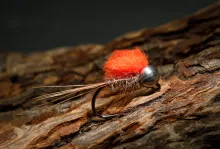The Pheasant tail nymph is a true classic. The original was tied by Frank Sawyer using only copper thread and phesant tail fibers. This pattern has been elaborated a bit by Charles A.Garwood from North Carolina, and uses peacock herl for the abdomen and regular tying thread.

The Pheasant tail nymph is a true classic. The original was tied by Frank Sawyer using only copper thread and phesant tail fibers. This pattern has been elaborated a bit by Charles A.Garwood from North Carolina, and uses peacock herl for the abdomen and regular tying thread.
| Hook | 12-16 down eye wet fly hook |
| Weight | Copper wire |
| Thread | Tan |
| Tail | Phesant tail fibers |
| Body | Phesant tail fibers |
| Rib | Copper wire |
| Abdomen | Peacock herl |
| Wing case | Phesant tail fibers |
| Hackle | False and sparse from phesant tail fibers |
| Head | Color of thread |
- Form a small oval ball of copper wire on the front half of the hook shank
- Tie in a few phesant tail fibers as tail over the hook bend. 6-10 will suffice.
- Tie in copper wire
- Wind the phesant tail fibers to the middle of the hook shank an tie down. Leave surplus.
- Wind the copper ribbing opposite the body, tie down and cut surplus.
- Tie in a few peacock herl. 2-4 will suffice.
- Wind the to just behind the hook eye to form a fairly thick abdomen
- Pull the phesant tail fibers forwards over the abdomen to form a wing case.
- Tie down and cut surplus.
- Tie in a few phesat tail fibers to form a false hackle. 3-5 in each side will suffice.
- Form a small head over the materials.
- Whip finish and varnish.
- Log in to post comments







